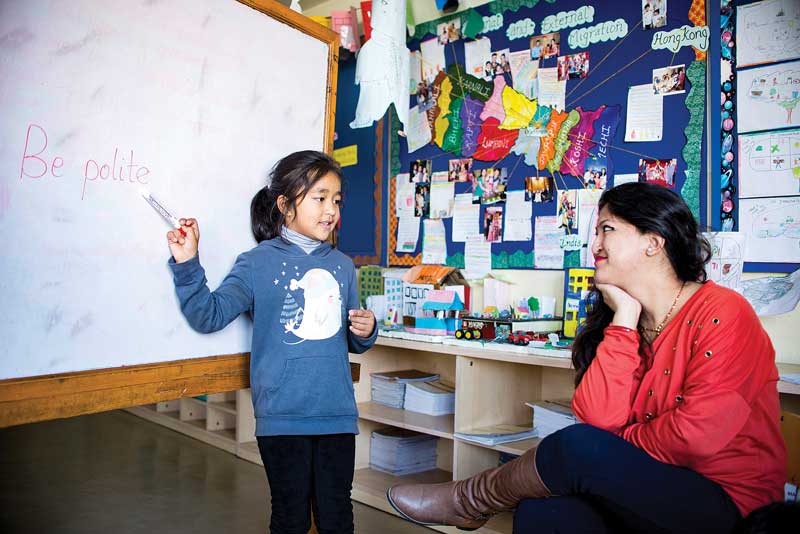Children as Our Teachers
From time immemorial, we adults unconditionally positioned ourselves in the high pedestal, and took our position as teachers to our children. But acknowledging for a change the subtle role played by children as our teachers is perhaps the first step towar

My youngest daughter Tanisha, who is in Grade 3, comes and teaches me how to change the settings in my mobile phone for her to play Minecraft, and updates me on new trendy songs on Youtube. Does not that make her my teacher?
If we study to our history, we find that in this part of the world teachers were highly respected. There is even an ancient Sanskrit sloka on how a young ascetic went into a forest and saw two individuals -- the human personification of God, and his teacher -- standing next to each other. He walked over, and touched the feet, as a mark of respect, first of his teacher and then of God. The order in which he paid respect shows that the teacher ranks higher – at least symbolically -- than God because of the teacher’s role in dispelling ignorance, and guiding the student away from evil.
The major difference between a traditional teacher (say, someone who teaches algebra), and a child is that the first comes with the explicit objective to instruct, but the second teaches just by being who she is. From this perspective, you could say that my daughter is in a unique position of being both: she taught me how to use mobile phone, and continues to teach me (more on this below) how to be a better human. The impact of a child’s influence – the things she teaches us by her behavior, and simply by her presence, in ways not yet fully understood -- can sometimes be of far greater significance. Some of the ways children teach us in this relatively obscure and unseen way, often without both parties (the teacher and the student) being aware of the process, and change our lives for the better, are given below.
Children transform us into better human beings through the example of their unconditional love and compassion. You could even say that they teach us through their action, more than through their words. It is said that soon after the birth of his daughter, one of the wealthiest persons in the world Bill Gates suddenly became more charitable. It is my assumption that the change took place because of his daughter’s love for him. I am sure there are many other people like him who became more mellow, kind, understanding, and generous as a result of the positive influence of children. One way or another, the world is in a slightly better position now thanks to the good work being undertaken by the Bill and Melinda Gates Foundation, and thanks to their daughter.
Children teach us how to live life without prejudice. Often times when I look out of my window I see children of many different ethnic, cultural, economic, religious, and language backgrounds playing together outside our house, and having fun. Their understanding of each other is not tainted by prejudices that we unfortunately find in many adults. Perhaps we should all learn how to accept other people the way they are from these children. These lessons are more important these days when divisive forces are gaining ground in many parts of the world. While many of the adults are into building more walls, children are the ones who show us the need to tear them down.
Their understanding of each other is not tainted by prejudices. Perhaps we should all learn how to accept other people the way they are from these children. While many of the adults are into building more walls, children are the ones who show us the need to tear them down.
Children teach us how to enjoy simple pleasures of life. In one of the episodes of the popular TV sitcom “Everybody Loves Raymond,” Raymond’s five-year old daughter Ally is shown eating a candy, with a big grin. On seeing his daughter enjoying a simple candy with such delight, Raymond says that as adults we have lost the capability to enjoy a candy without at the same time thinking of toothache, obesity, money, or existential questions. Indeed, as adult we have forgotten how to enjoy simple pleasures of life without thinking of ancillary problems, and now need to relearn them from the children.
Children teach us how to forgive. You may have noticed that in many joint families in Nepal, sometimes parents in the family fight amongst themselves on account of the fights between their children. After sometime the children patch up and start playing together, while the parents would still not be talking to each other. Though it may seem demeaning for the parents to follow the children’s example and let go of their animosities, that’s what they need to do.
The points mentioned above are just a small sample of what we can learn from children. I am sure there are many other things we can learn from them, and there are many ways “teaching” can take place between children and us. The famous cartoonist Frank A. Clark even went on to say, “Every adult needs a child to teach; it’s the way adults learn.”
The next time you see a child, do not dismiss her as someone who is beneath you because you know more than her, but hug her, and respect her as a teacher. Many of us during Dashain worship and touch the feet of young boys as representation of Kumar and Ganesh, and young girls as representation of Living Goddess Kumari. Cultural practices aside, one additional reason to touch their feet would be to acknowledge their role as teachers who teach us to learn to live life as true human beings.


